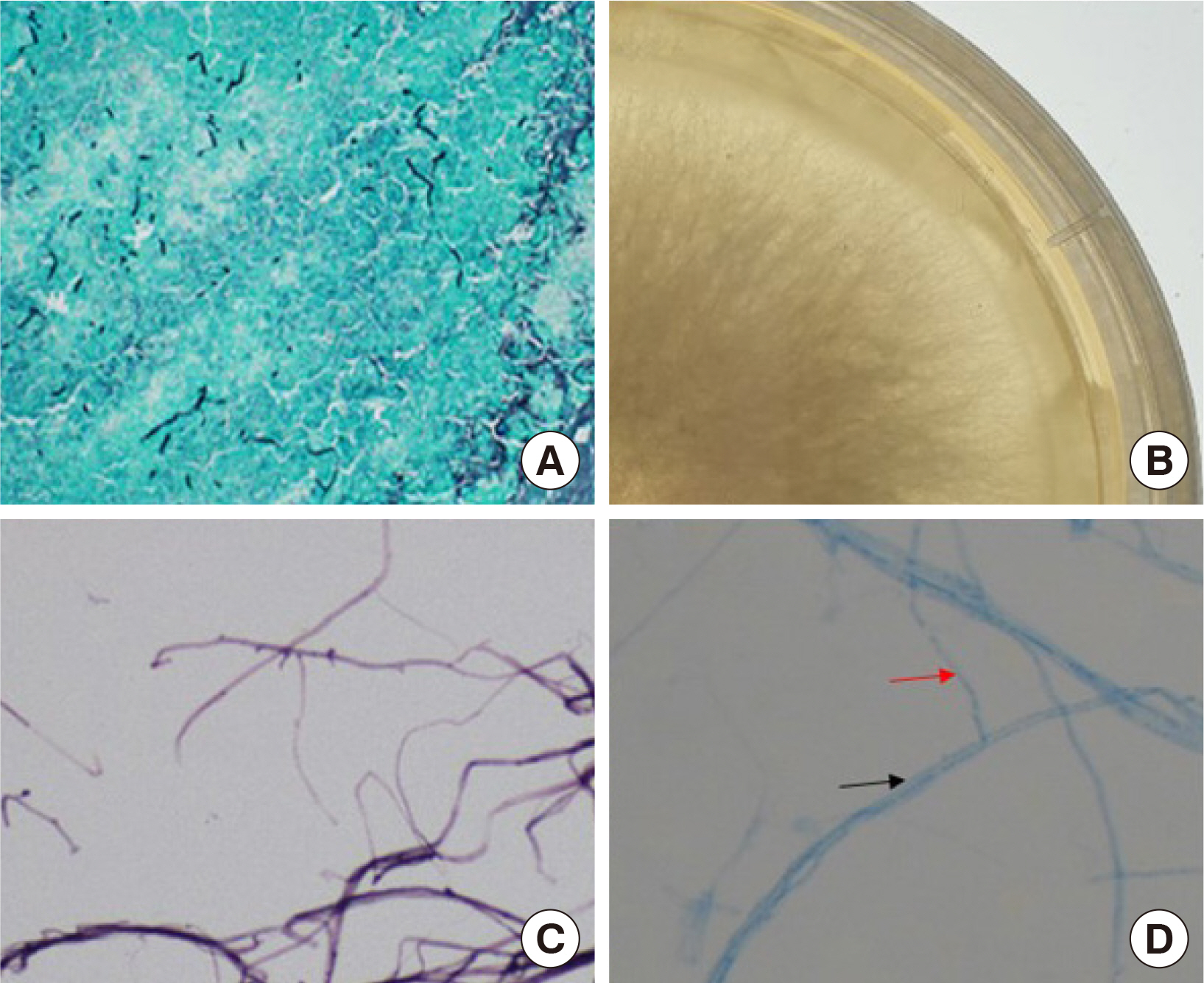Lab Med Online.
2023 Jan;13(1):27-30. 10.47429/lmo.2023.13.1.27.
A Rare Case of Bronchiectasis with Mucoid Impaction Caused by Schizophyllum commune in an Immunocompetent Woman in South Korea
- Affiliations
-
- 1Department of Laboratory Medicine, Kangbuk Samsung Hospital, Sungkyunkwan University School of Medicine, Seoul, Korea
- 2Division of Pulmonary and Critical Care Medicine, Department of Internal Medicine, Kangbuk Samsung Hospital, Sungkyunkwan University School of Medicine, Seoul, Korea
- 3Department of Pathology, Kangbuk Samsung Hospital, Sungkyunkwan University School of Medicine, Seoul, Korea
- 4Department of Radiology, Kangbuk Samsung Hospital, Sungkyunkwan University School of Medicine, Seoul, Korea
- KMID: 2552721
- DOI: http://doi.org/10.47429/lmo.2023.13.1.27
Abstract
- Schizophyllum commune is one of most widely distributed fungal species, often found on dead and decaying organic matter. Only a few cases of S. commune infections in immunocompetent patients, including the sinus, sino-orbital, bronchopulmonary, and extra-pulmonary areas have been reported. A 52-year-old female patient presented with symptoms of cough, whitish sputum, and chest discomfort lasting approximately one month. The patient denied any relevant medical history. Chest radiography revealed a mass-like consolidation at the right lower lobe. Bronchoscopy showed thick, white-yellowish mucoid plugs on several bronchi on the right middle lobe. Transbronchial biopsy and aspiration were performed. Gomori’s methenamine silver staining on a prepared paraffin block and fungal culture revealed a few scattered degenerated fungal hyphae. DNA amplification and sequencing analysis of the Internal Transcribed Spacer gene demonstrated 100% identity with S. commune; access number MK029865.1. The patient was diagnosed with bronchiectasis with mucoid impaction caused by S. commune fungal infection and recovered fully after 4 weeks of oral administration of itraconazole 200 mg twice a day. In Korea, there have been only two cases of fungal infections caused by S. commune in immunocompetent patients. The cases were allergic fungal sinusitis and sino-orbital infection. This report provides additional evidence that invasive fungal infection by S. commune is possible in immunocompetent patients.
Figure
Reference
-
1. Hibbett DS, Binder M, Bischoff JF, Blackwell M, Cannon PF, Eriksson OE, et al. 2007; A higher-level phylogenetic classification of the Fungi. Mycol Res. 111:509–47. DOI: 10.1016/j.mycres.2007.03.004. PMID: 17572334.2. Chowdhary A, Kathuria S, Agarwal K, Meis JF. 2014; Recognizing filamentous basidiomycetes as agents of human disease: a review. Med Mycol. 52:782–97. DOI: 10.1093/mmy/myu047. PMID: 25202126.3. Chowdhary A, Randhawa HS, Gaur SN, Agarwal K, Kathuria S, Roy P, et al. 2013; Schizophyllum commune as an emerging fungal pathogen: a review and report of two cases. Mycoses. 56:1–10. DOI: 10.1111/j.1439-0507.2012.02190.x. PMID: 22524529.4. Rihs JD, Padhye AA, Good CB. 1996; Brain abscess caused by Schizophyllum commune: an emerging basidiomycete pathogen. J Clin Microbiol. 34:1628–32. DOI: 10.1128/jcm.34.7.1628-1632.1996. PMID: 8784558. PMCID: PMC229083.5. Tone K, Fujisaki R, Hagiwara S, Tamura T, Ishigaki S, Alshahni MM, et al. 2018; Epidural abscess caused by Schizophyllum commune: A rare case of rhinogenic cranial complication by a filamentous basidiomycete. Mycoses. 61:213–7. DOI: 10.1111/myc.12729. PMID: 29125646.6. Michel J, Maubon D, Varoquaux DA, Boulze C, Normand AC, Righini CA, et al. 2016; Schizophyllum commune: an emergent or misdiagnosed fungal pathogen in rhinology? Med Mycol. 54:301–9. DOI: 10.1093/mmy/myv084. PMID: 26613704.7. Bulajic N, Cvijanovic V, Vukojevic J, Tomic D, Johnson E. 2006; Schizophyllum commune associated with bronchogenous cyst. Mycoses. 49:343–5. DOI: 10.1111/j.1439-0507.2006.01247.x. PMID: 16784453.8. Kim H, Yi Y, Cho SY, Lee DG, Chun HS, Park C, et al. 2022; Pneumonia due to Schizophyllum commune in a patient with acute myeloid leukemia: Case report and literature review. Infect Chemother. 54:195–201. DOI: 10.3947/ic.2020.0068. PMID: 33124214. PMCID: PMC8987182.9. Lee JM, Han E, Kim J, Park JH, Sung GH, Shin JH, et al. 2020; Five Korean cases of respiratory tract infection by filamentous basidiomycetes. Ann Lab Med. 40:84–7. DOI: 10.3343/alm.2020.40.1.84. PMID: 31432646. PMCID: PMC6713658.10. Won EJ, Shin JH, Lim SC, Shin MG, Suh SP, Ryang DW. 2012; Molecular identification of Schizophyllum commune as a cause of allergic fungal sinusitis. Ann Lab Med. 32:375–9. DOI: 10.3343/alm.2012.32.5.375. PMID: 22950076. PMCID: PMC3427828.11. Sa HS, Ko KS, Woo KI, Peck KR, Kim YD. 2012; A case of sino-orbital infection caused by the Schizophyllum commune. Diagn Microbiol Infect Dis. 73:376–7. DOI: 10.1016/j.diagmicrobio.2012.05.005. PMID: 22673964.12. Cavanna C, Pagella F, Esposto MC, Tamarozzi F, Clemente L, Marone P, et al. 2019; Human infections due to Schizophyllum commune: case report and review of the literature. J Mycol Med. 29:365–71. DOI: 10.1016/j.mycmed.2019.100897. PMID: 31543381.13. Brandt ME. 2013; Filamentous basidiomycetes in the clinical laboratory. Curr Fungal Infect Rep. 7:219–23. DOI: 10.1007/s12281-013-0148-8. PMID: 26512308. PMCID: PMC4621262.14. Ishiguro T, Takayanagi N, Tokunaga D, Kurashima K, Matsushita A, Harasawa K, et al. 2007; Pulmonary Schizophyllum commune infection developing mucoid impaction of the bronchi. Yale J Biol Med. 80:105–11.15. Kaur M, Chander J, Singla N, Das A, Sood S, Guarro J. 2020; Sino-orbital infection caused by Schizophyllum commune-rare presentation of a basidiomycetous fungus. J Mycol Med. 30:100934. DOI: 10.1016/j.mycmed.2020.100934. PMID: 32037101.16. Shen Q, Yao YK, Yang Q, Zhou JY. 2016; Schizophyllum commune-induced pulmonary mycosis. Chin Med J (Engl). 129:2141–2. DOI: 10.4103/0366-6999.189062. PMID: 27569249. PMCID: PMC5009606.17. González GM, Sutton DA, Thompson E, Tijerina R, Rinaldi MG. 2001; In vitro activities of approved and investigational antifungal agents against 44 clinical isolates of basidiomycetous fungi. Antimicrob Agents Chemother. 45:633–5. DOI: 10.1128/AAC.45.2.633-635.2001. PMID: 11158771. PMCID: PMC90343.
- Full Text Links
- Actions
-
Cited
- CITED
-
- Close
- Share
- Similar articles
-
- Pneumonia due to Schizophyllum commune in a Patient with Acute Myeloid Leukemia: Case Report and Literature Review
- Draft Genome Sequence of the White-Rot Fungus Schizophyllum commune IUM1114-SS01
- Molecular Identification of Schizophyllum commune as a Cause of Allergic Fungal Sinusitis
- Identification of Long Non-Coding RNAs and Their Target Genes from Mycelium and Primordium in Model Mushroom Schizophyllum commune
- Pulmonary Consolidation Pattern on the Chest CT: Malignant vs Benign



